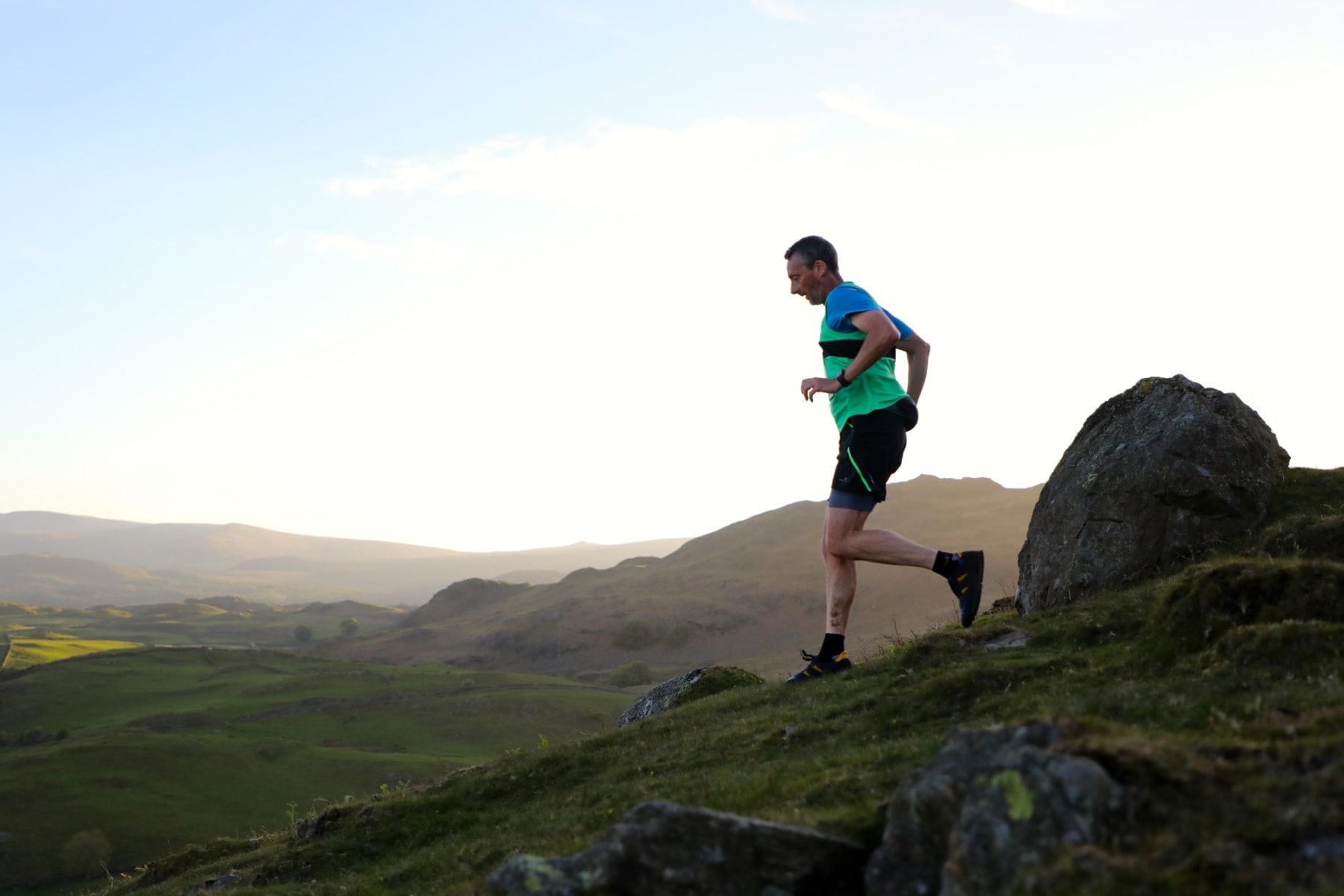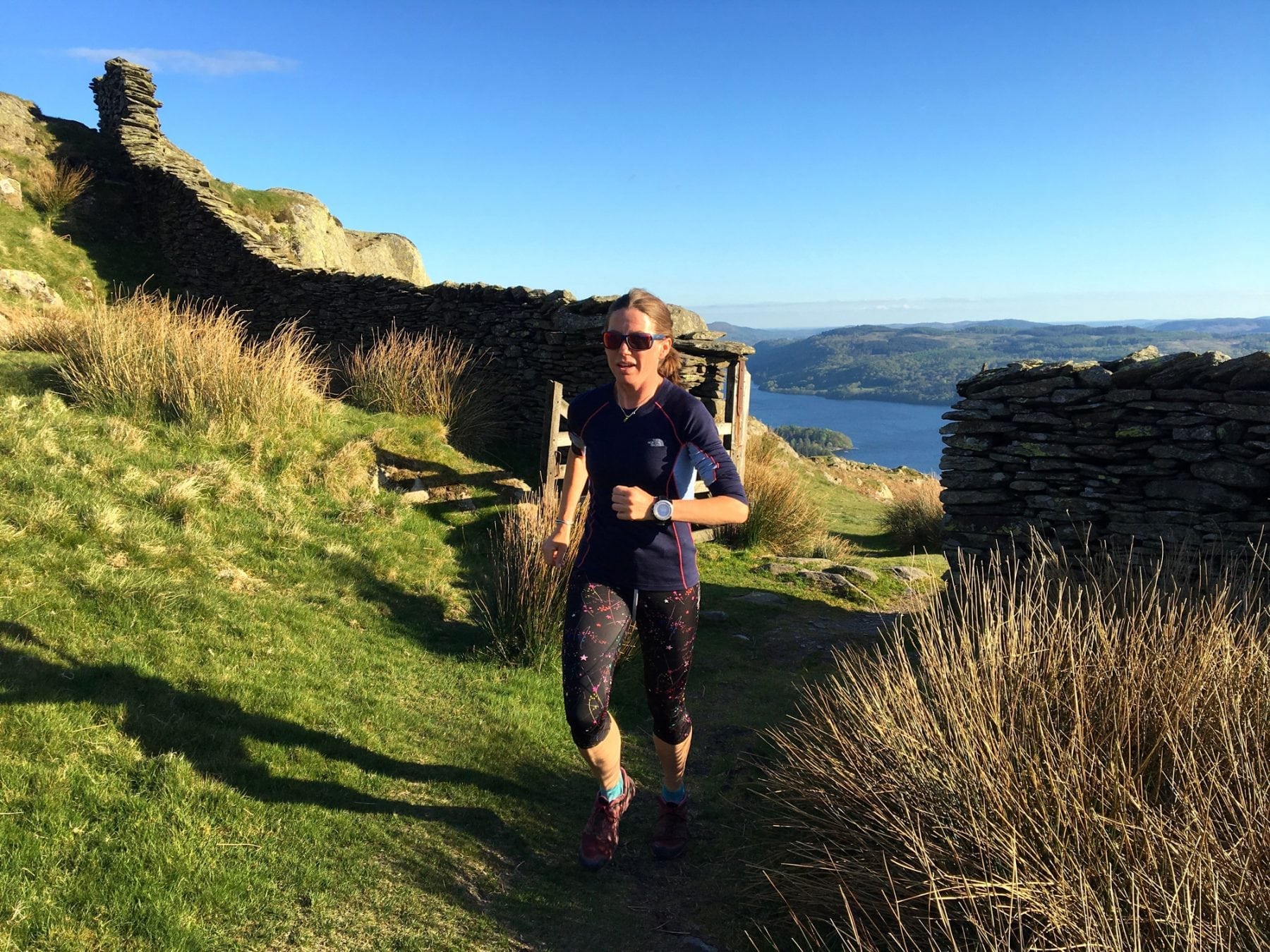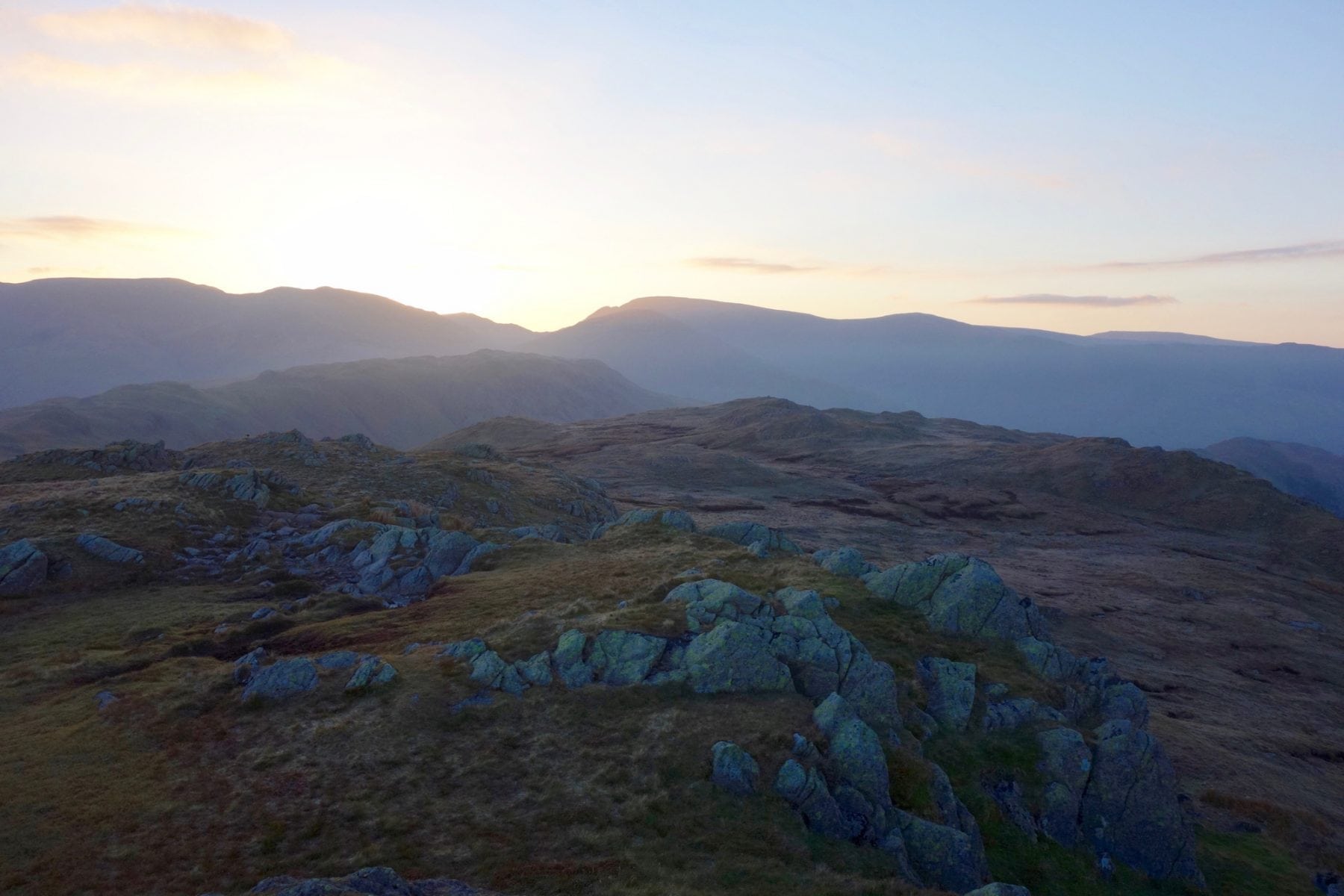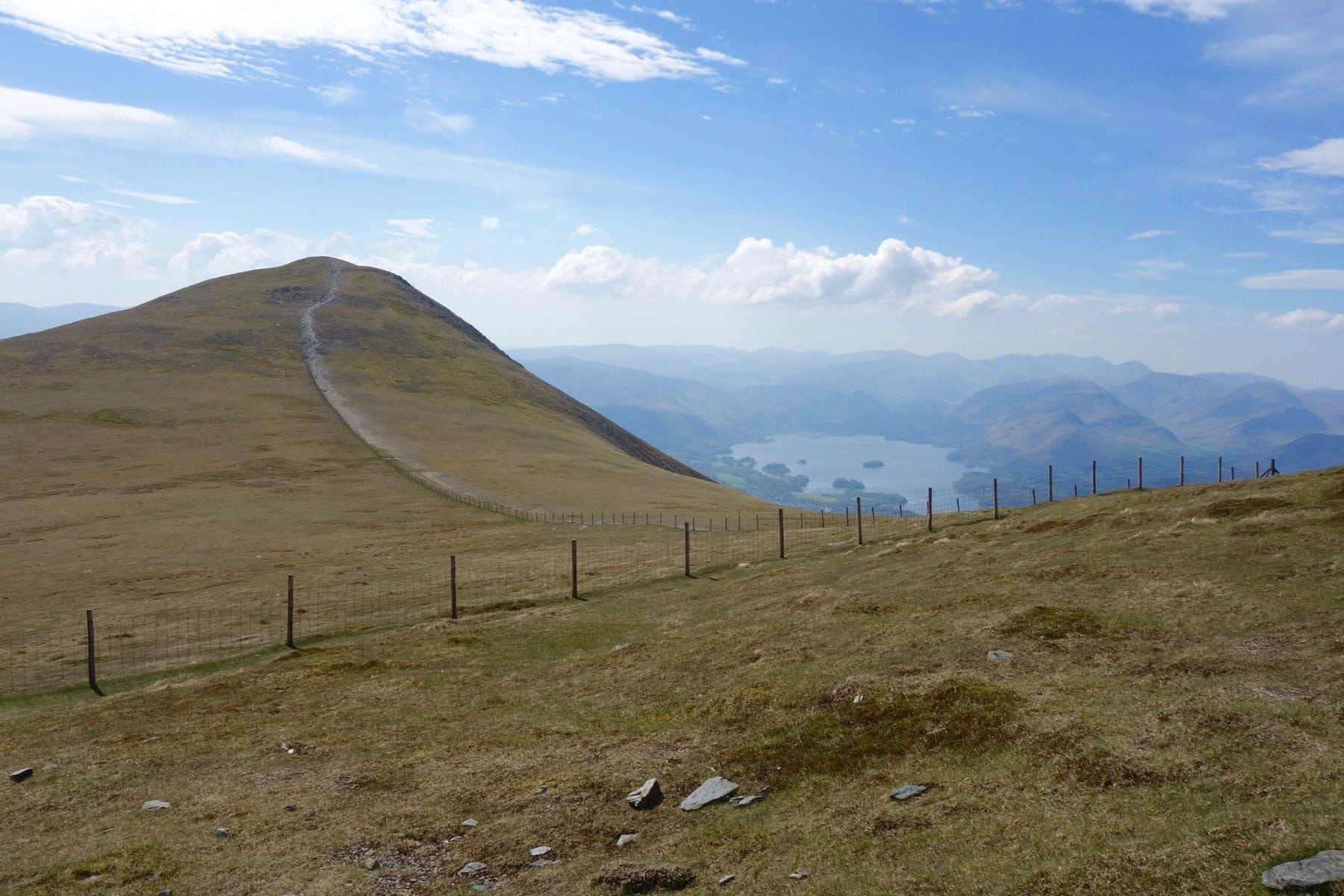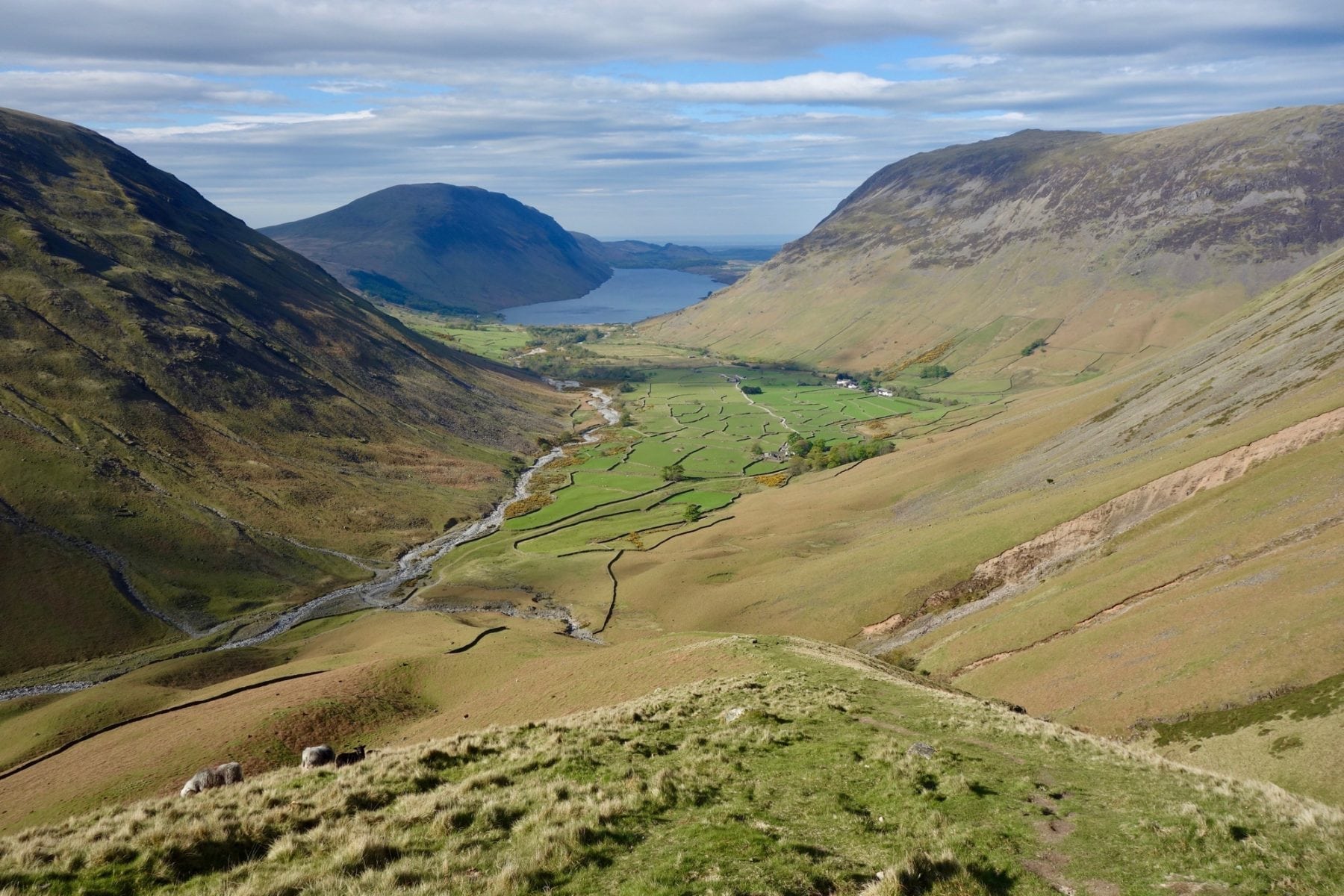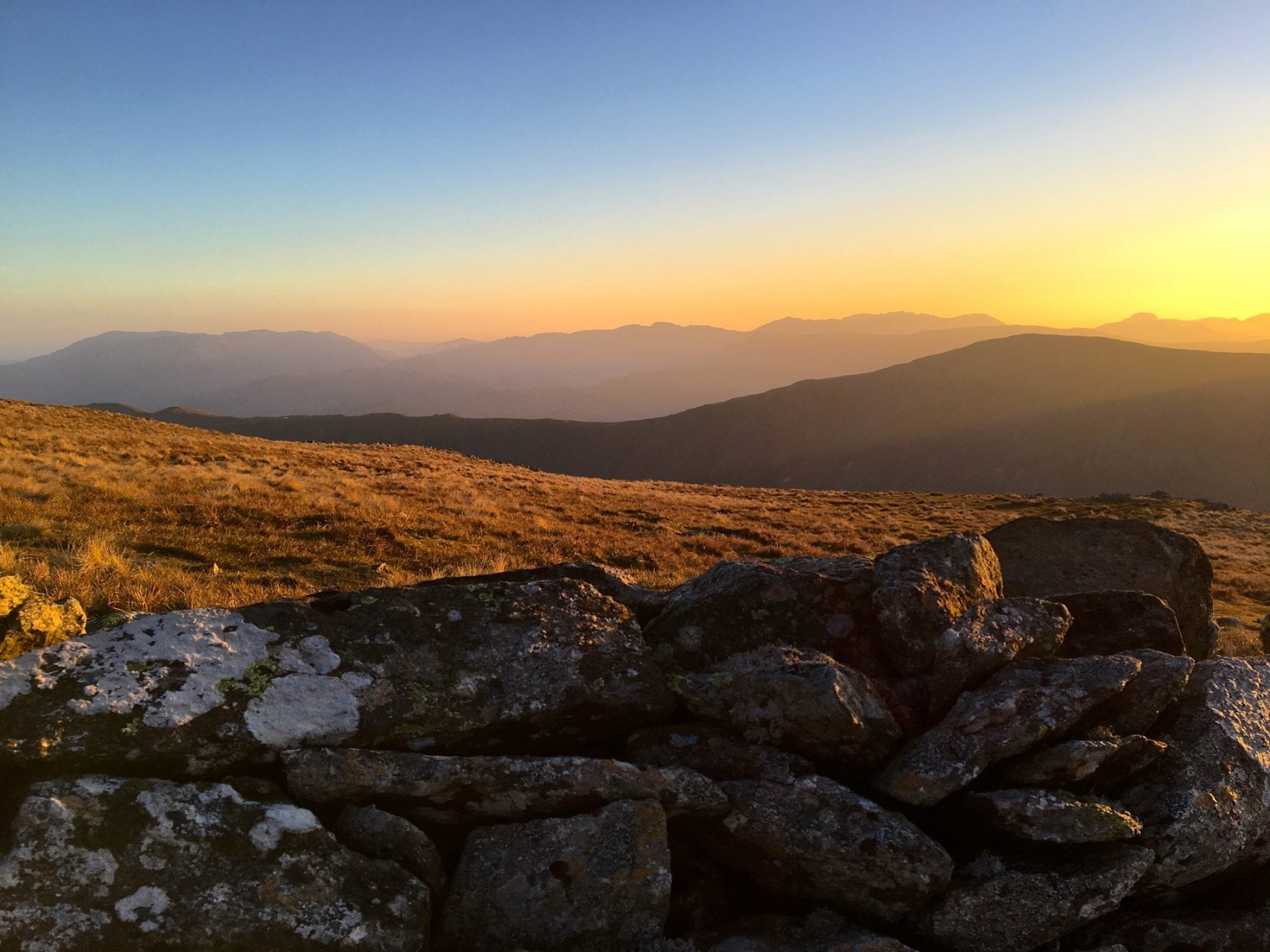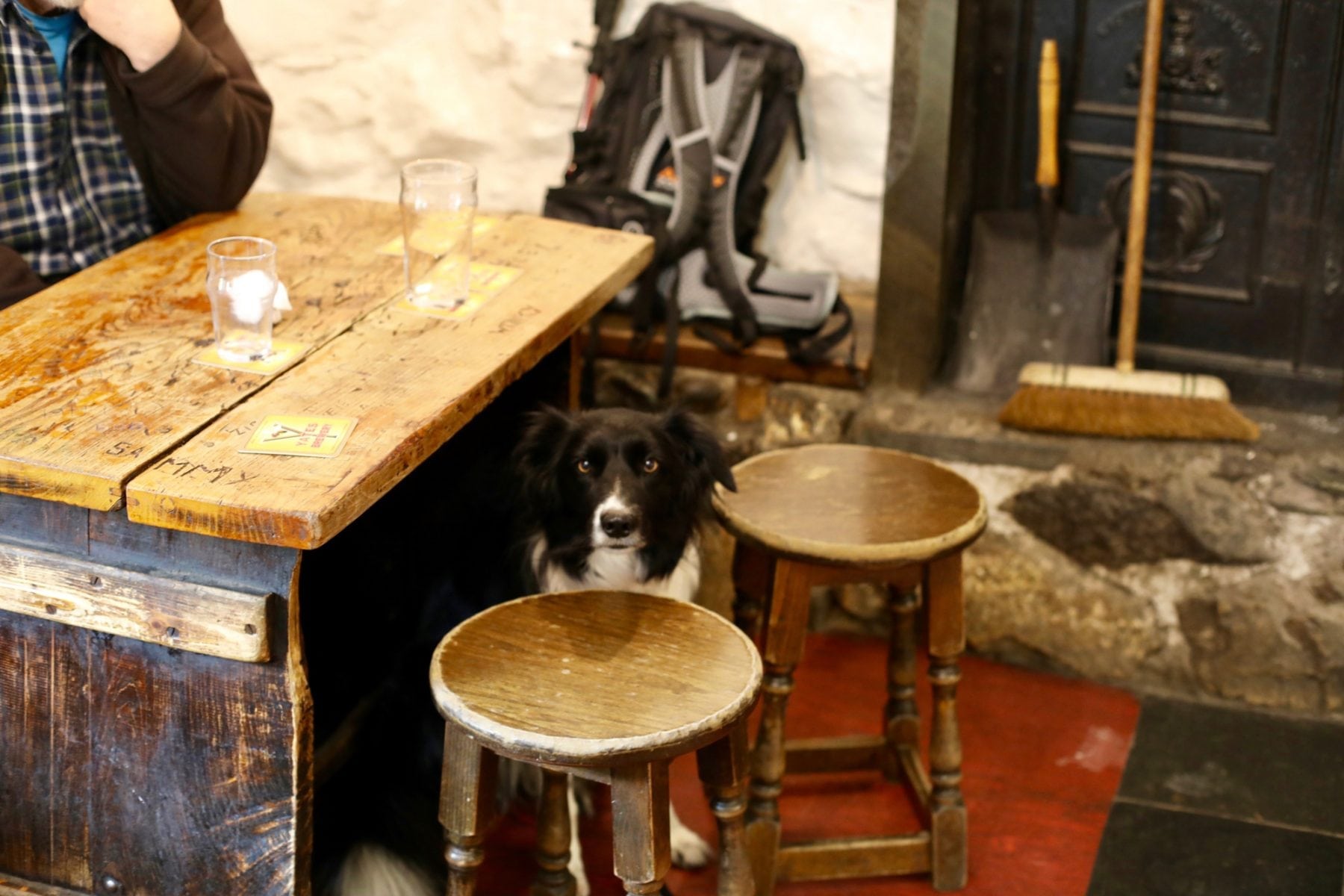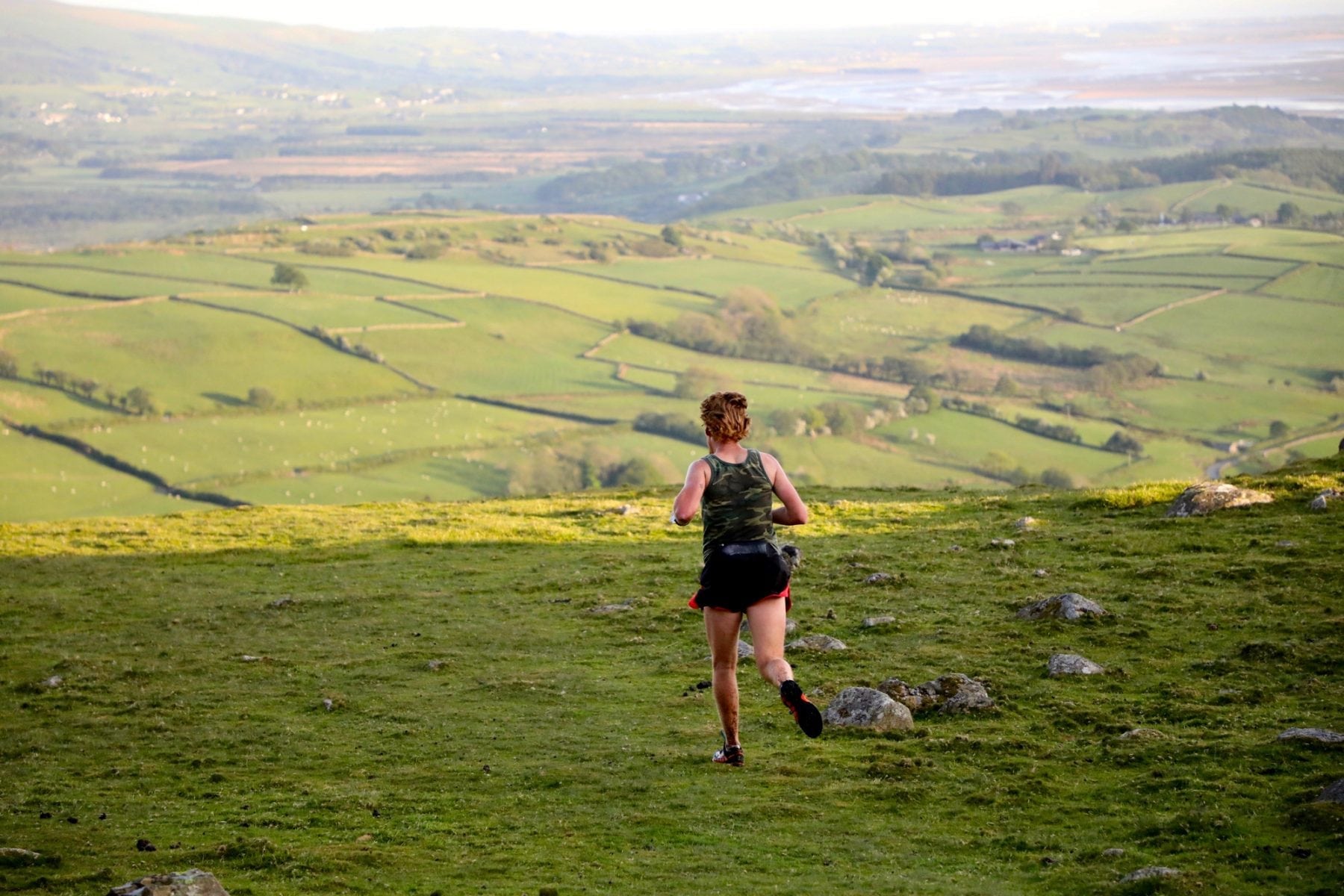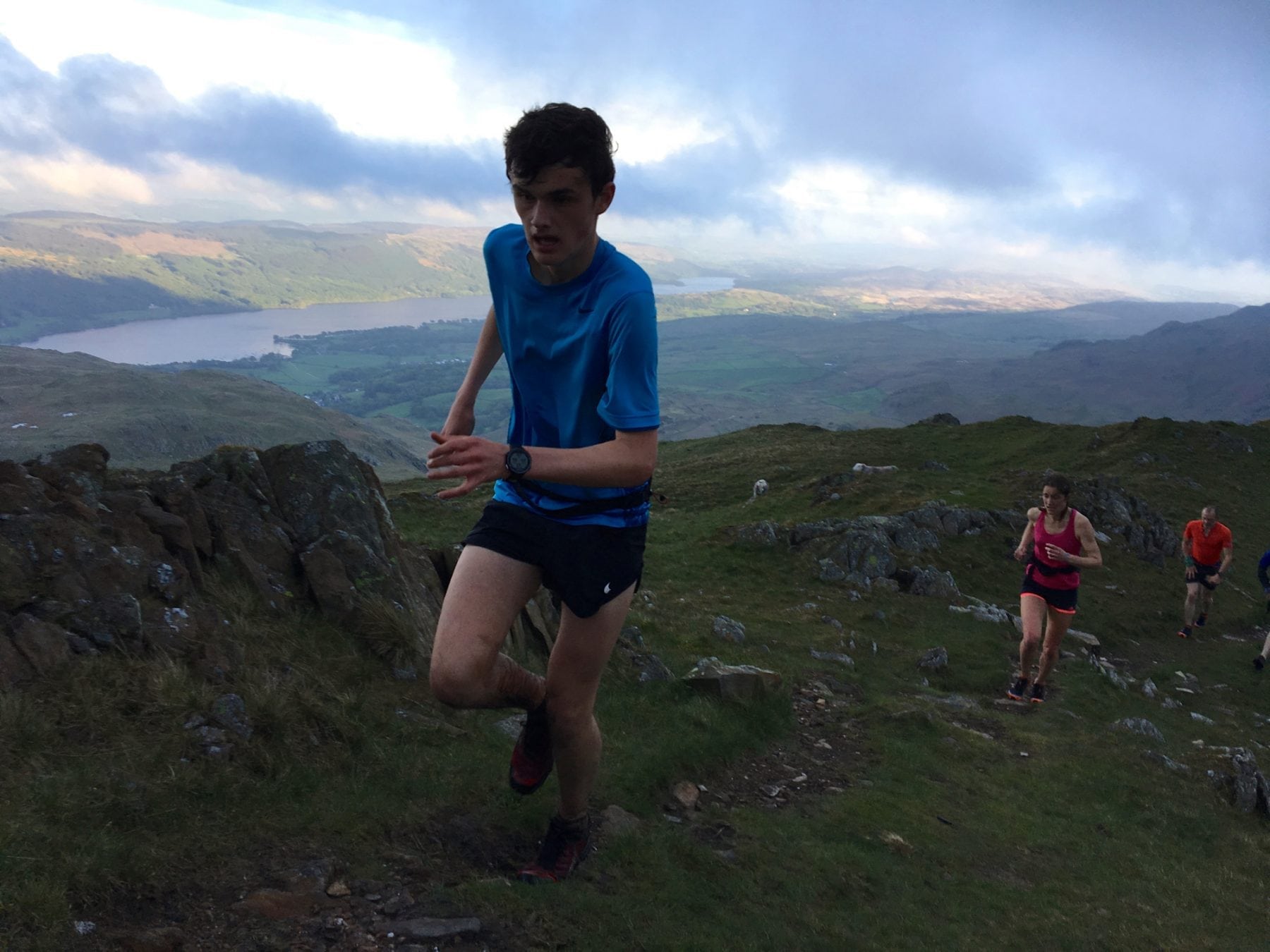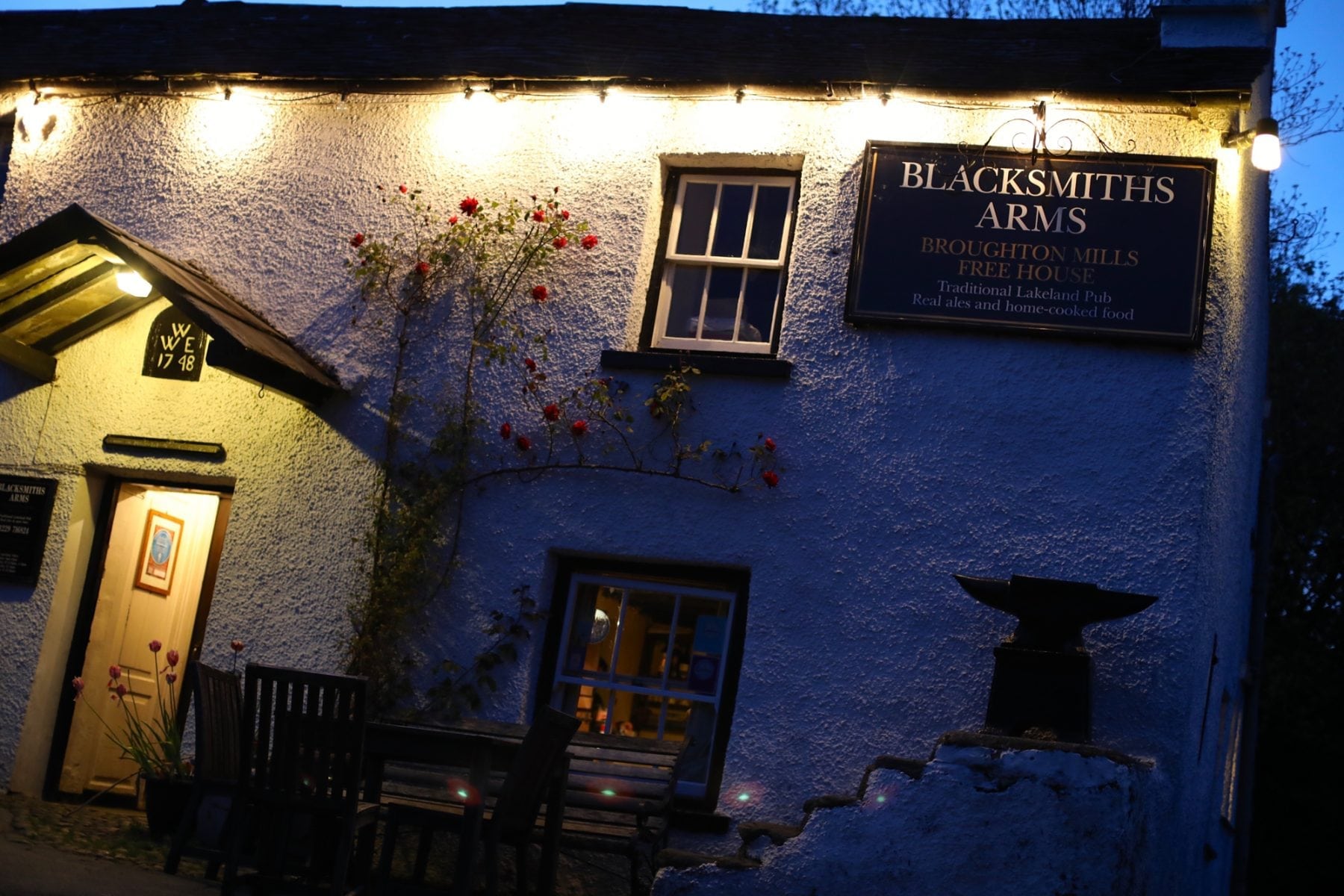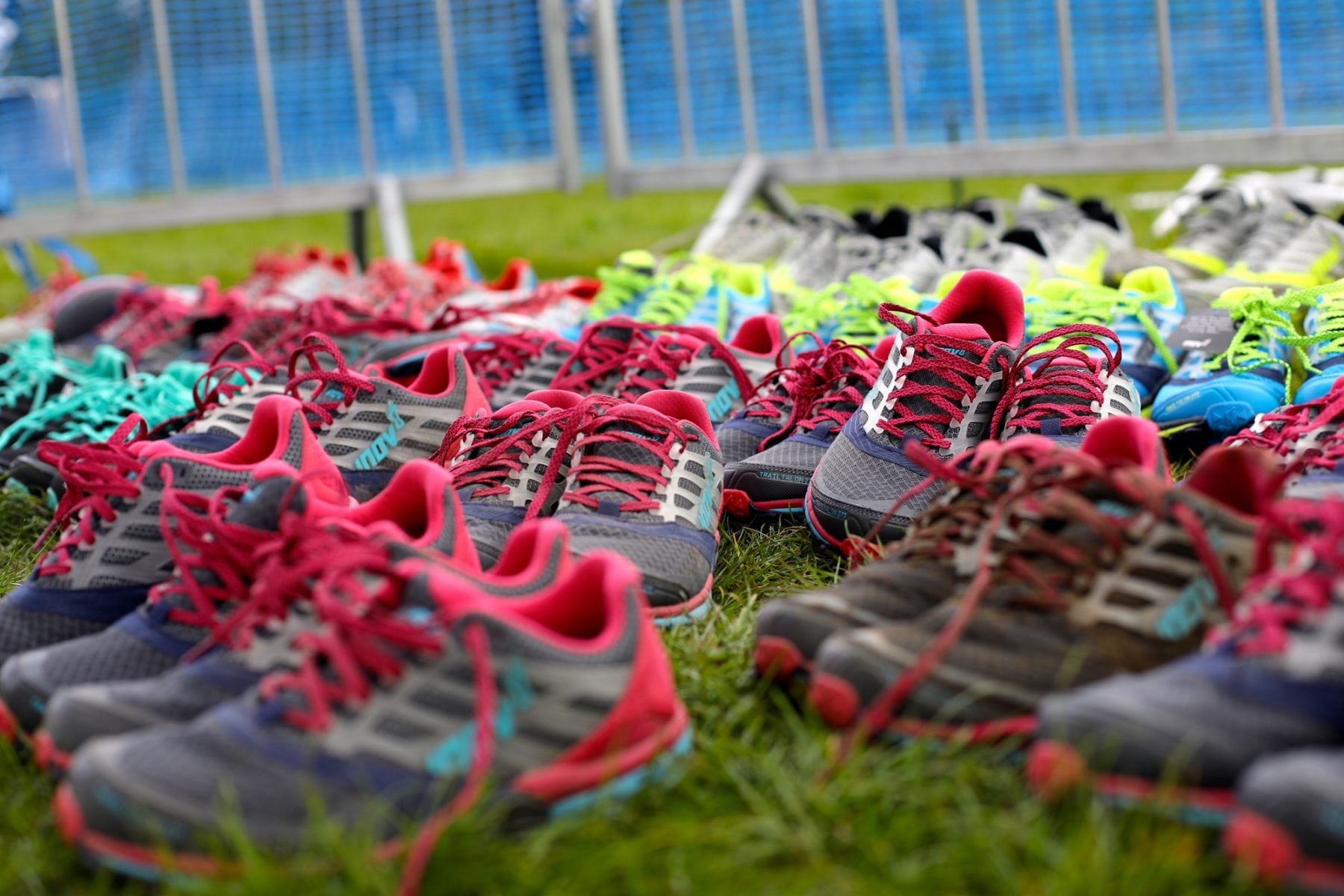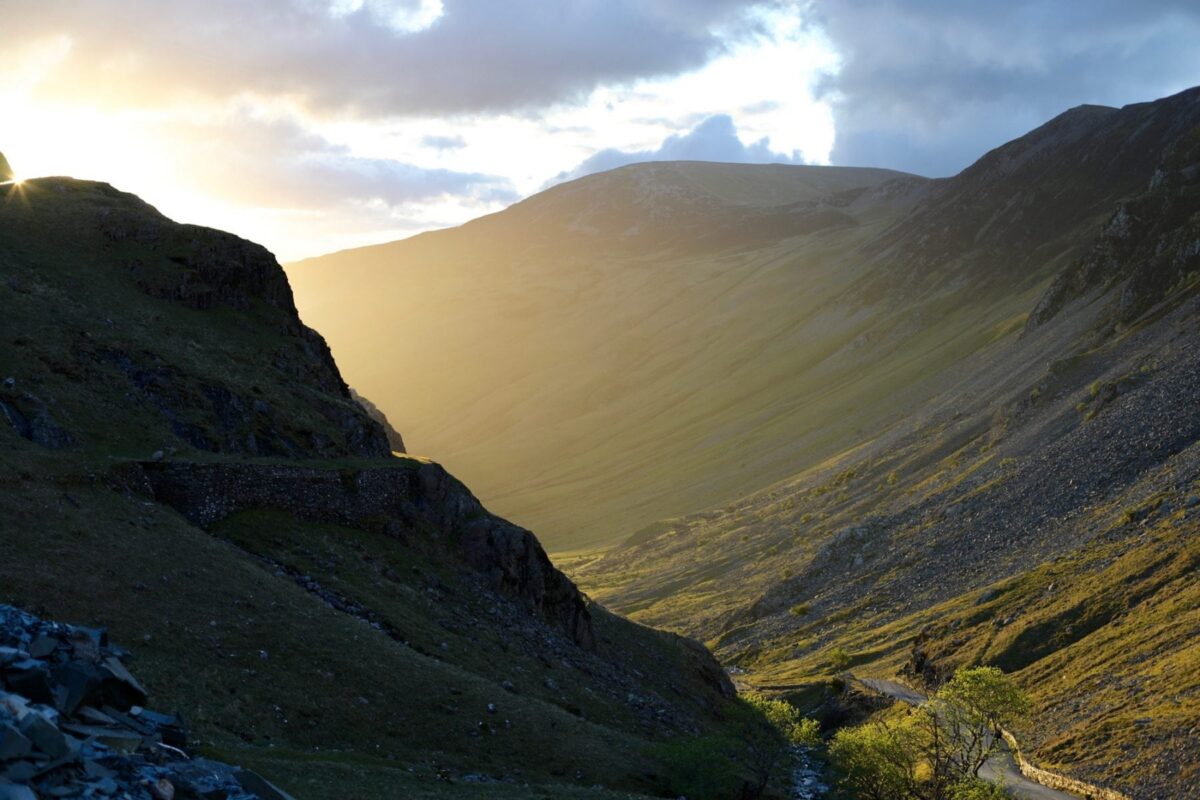The Lake District, often just called the Lakes or sometimes Lakeland, is located at the far north of England, contained entirely within the county of Cumbria. At 912 square miles (2,362 square kilometers), we’re talking about a hefty piece of landscape, and it’s known, I suppose obviously, for its lakes. It’s also known—especially to pedestrian recreationists—for its fells, or treeless mountains of various sorts, as well as its lower-altitude forests. England’s high point, Scafell Pike, sits in the Lake District at 3,208 feet (978 meters) in height.
Adding to the naming confusion for non-locals is the fact that Lake District National Park, established in 1951, shares a similar overall boundary with the Lake District itself. Unlike many national parks around the world, where the land contained within them is federally owned and/or public land, much of Lake District National Park’s land is privately owned, as it has been for millennia. In July 2017, between when iRunFar visited the Lake District and this article’s publishing, it was named a UNESCO World Heritage Site because of its significant cultural heritage. Interestingly, the district had been previously rejected as a nature-based site, because the region has been so extensively populated and modified by humans over the very long human history in the region.
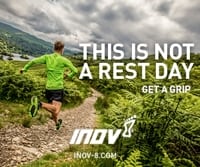 In the spring of 2017, iRunFar’s Bryon Powell and Meghan Hicks spent nearly a month visiting and running ‘round the Lake District, and the intertwinement of nature and culture was one of the most fascinating experiences for us. Special thanks to inov-8 for helping make our trip to the Lake District and this story possible!
In the spring of 2017, iRunFar’s Bryon Powell and Meghan Hicks spent nearly a month visiting and running ‘round the Lake District, and the intertwinement of nature and culture was one of the most fascinating experiences for us. Special thanks to inov-8 for helping make our trip to the Lake District and this story possible!
For a national park, the Lake District is decently populated and even more heavily visited. The district is populated by some 41,000 people, but receives extremely heavy visitation. Lake District National Park says its visited annually by 15.8 million tourists. For comparison, this places it on par with the most heavily visited American National Park Service area, the Golden Gate National Recreation Area in the San Francisco Bay Area of California, which received 15.6 million visitors in 2016.
Make no mistake, the region can feel crowded, if you’re in the ‘wrong’ place at the wrong time, like the streets of Keswick or Ambleside or on one of the region’s most popular trails on a sunny summer day. Wherever you are—even on the farthest fells, perhaps especially on the farthest fells—you’ll also share territory with sheep herds, and many times you’ll pass through or quite close to farms around trailheads. Sometimes, a trail will empty itself into the dead center of a town, too, and you’ll find yourself in short shorts and bearing a hydration pack next to tourists fresh off a boat tour on one of the district’s massive lakes. Because there’s so much regional room to roam, and though you’ll certainly see others while you’re out on the fells, fell-top experiences can feel somewhat solitary so long as you avoid peak times on popular peaks.
“The fells and the valleys and the farms and the villages and the sheep and the pubs and the quarries and the lakes and the drystone walls are the Lakes. This is not wilderness. Human impact is everywhere across the landscape, but it’s rarely displeasing,” explains Joe Williams. He’s a Kendal-based fell runner who has lived in the Lake District since age 13. He continues, “The fells are bare, rocky, and smooth with clipped grass because of deforestation and the grazing of sheep that has occurred for many hundreds of years. People have been farming on the hills for many, many generations, but people have been climbing, running, or testing their endurance on the same hills for well over 100 years now, too.”
We also asked inov-8 runner Jasmin Paris what she thought about the nature-culture interaction that seems, at least to us visitors, inherent to the region. Jasmin currently lives near Edinburgh, Scotland, and she grew up in the not-too-distant Peak District of England. She regularly runs in the Lake District and has a downright obscene number of wins and records in the region’s fell races and runs. She said, “The landscape is part of peoples’ lives, and as such it is respected not only for its beauty, but also for the farming (and more recently) the tourism it supports. It’s a delicate balance, though, and one that will be crucial if the Lake District is to maintain its identity in the future.”
What we ultimately found in the Lake District was what felt like a close-to-sustainable marriage between nature and culture. As in, it can be fun to share fell tops with other enthusiasts, and the pubs in town or back at the trailhead are remarkable places to swap stories and listen to the locals talk about regular Lake District life, and the fell-running and trail-running cultures which have emerged from this centuries-old nature-culture relationship are darn special.
With the balance of this article, we attempt to describe the Lake District’s nature and culture as we experienced it. Thus, this article is written by visitors for other potential visitors to the region.
[Authors’ Note: This article was co-authored by Meghan Hicks and Bryon Powell. We’ll indicate throughout the article which of us penned each section.]
Off-Road Running in the Lakes – Meghan
It’s all about the running, isn’t it? First things first.
Right, so you’ve heard about this thing called fell running. What exactly is it and how is it different from trail running? Well, it’ll all make sense once you’re in the Lake District, but I think the best way to succinctly describe the difference is that trail running sticks to the trails while fell running incorporates all parts of the landscape—from spongy tundra, to knee-deep bogs, to hard-pack trail, to rocky talus fields, to scramble-y cracks, and more—into a single run. In fell running, special attention is paid to the aesthetic and efficiency of the line traveled to get up and, then, down a mountain, and, then, onto the next.
For example, most mountains in the Lake District have a trail or trails that go bottom to top, and from one to the next. Beyond the trails, there’s landscape galore that’s open territory for fell running. A trail runner would connect the mountains on the established trails, while a fell runner might use the trails as just one possible means among many of making the journey.
Local fell runners will parse things out even more, in describing how their movement on the fells change if they are running or racing and in describing how the fell running experience is unique for each person. On that last point, I highly recommend you place yourself in the company of two fell runners as they talk about different routes up a single mountain, often describing variations of a couple-dozen feet in one direction or another on the same side of a mountain as entirely different routes. And once you watch a short-and-fast fell race, you’ll understand why routes are parsed to nth degrees, as a variation that’s one second more efficient can mean winning the race.
From here out in this section, I offer a number of sample locations for fantastic day on, below, and/or between the fells—most times on trail and sometimes off trail.
Skiddaw
Skiddaw might be one of the most popularly hiked fells, as its prominence just above the Lake District’s population and tourist center of Keswick makes it an easy target. Getting to the top of many of the region’s big fells involves almost a vertical kilometer of climb, and Skiddaw is nearly that at 3,053 feet (931 meters) of climb required. It’s almost exactly 10 miles (16 kilometers) roundtrip from downtown Keswick to the Skiddaw summit and back, by way of going over the slightly smaller Skiddaw Little Man on the way. A whole bunch of the most common route to the top, following the Cumbria Way path out of town and, then, turning off on the Skiddaw summit trail proper, is runnable, but there are a couple super-steep punches here and there. Run back to town from whence you came!
Side note, as is the case with nearly every fell in the Lake District, there are multiple routes up the mountain, via big trails, little trails, and no trails. Choose your own adventure, but keep it in the realm of what you can navigate (particularly when the weather gets tricky) and environmentally sustainable (don’t cause erosion with your tramping). And, if you’re looking for a quieter experience, I recommend an early morning outing, as I noted many of the tourist hikers starting their jaunt between 9 and 10 a.m., or in the evening, when everyone’s in town sipping sundowners, for a sunset cruise. If you choose the latter later outing, most pubs—including the more remote ones—will serve dinner until 8 or 9 p.m. Check before you go out, though!
The ‘Roof of England’ and Scafell Pike
Want to get to England’s high point? If so, you’re not alone. It seems like everyone who comes to the Lake District for on-foot travel seeks Scafell Pike as one of their destinations. There can be a downright immense number of people on the mountain summit at times. We’re talking a couple hundred. If you go, again I recommend early morning or late afternoon, before or after the daily rush. Or, go up in crappy weather. This doesn’t stop some people, but it will stop many.
There are a number of ways to go up Scafell Pike, with the most popular and shortest being from Wasdale at Brackenclose. If you’re feeling fancy, make a lollipop loop out of the route by using Mickeldore Col on the way up and Lingmell Col on the way down. This will earn you 6 miles (9.6 kilometers) and 3,244 feet (989 meters) of climb roundtrip—and a pint at the Wasdale Head Inn when you get back down.
If you’ve gone to the trouble of climbing up onto the ‘Roof of England,’ consider staying a little while to tag some of the other knobby fell tops in the vicinity. Some of them have trails connecting them, while others you can simply forge cross country through the tundra and rocks.
Wasdale Vicinity
Wasdale, a relatively quiet farmer’s valley in the western Lake District that throbs with pedestrian tourism at some times of the year, is really something else. You should go there and climb high on one of the fells above the valley—there are a number of choices aside from Scafell Pike described above—and take in the views. From many places above Wasdale, you’ll even have a view to the Irish Sea.
“I love all of the Lake District, but Wasdale has to be my favourite. It is wild and beautiful, and has the perfect mix of grassy and rocky terrain, becoming more technical on the section around Scafell. Wasdale is actually the valley where I proposed to [my now-husband] Konrad on a very stormy day in December of 2015. So, yes, it is a special place,” says Jasmin Paris about Wasdale.

Another view looking across Wasdale from Yewbarrow to Scafell Pike and Scafell. Photo: iRunFar/Meghan Hicks
Your choices of fells are endless, but may I recommend a loop from Wasdale Head over Kirk Fell and Great Gable via Black Sail Pass, up the famous Joss’s Gully (named for Wasdale fell-running icon and resident Joss Naylor), over the Kirk Fell summit, down to Beck Head, around to Windy Gap, up over Great Gable, down to Sty Head, and back to Wasdale Head. Phew! This loop rings in at about 8.2 miles (13.2 kilometers) with 3,550 feet (1,082 meters) of climb and takes you around the high country at the head of Wasdale. Wasdale Head Inn, of course, awaits your finish with ample reward.
Fairfield
Fairfield is one of the fells located in the eastern part of the Lake District that Bryon and I both made it to the top of several times, from several directions—and we both loved it. The village of Rydal serves as a great starting place for a most aesthetic ridgeline gander to Fairfield’s summit. You steadily gain altitude and hop over several other named fells en route, like Heron Pike, Rydal Fell, and Great Rigg.
Continue on along the ‘Fairfield Horseshoe’ by traversing southeast off the Fairfield summit and, then, south down the ridge to the east of the one you climbed up on, over such fells at Hart Crag, High Pike, and Low Pike. You’ll land back in the village of Ambleside, and it’s a brief road run back to Rydal. This geographical concept, a horseshoe of mountains around a long, U-shaped, glacier-carved valley, is repeated over and over throughout most of the Lake District and a number of them have become fell-racing territory, which we discuss in greater depth below. This horseshoe, for example, is the route of the annual Fairfield Horseshoe Fell Race.
The whole horseshoe with the road run back to complete the ‘U’ is 10.2 miles (16.4 kilometers) and has 3,543 feet (1,080 meters) of climb. There are other shorter and faster routes up Fairfield, and the spider web of trails, trods, and cairns about the summit combined with the fell’s broad and flat top makes it a darn confusing place in bad weather. No joke, in poor conditions a compass is required to get off that mountain in your intended direction!
Langdale Vicinity
Both Bryon and I fell a little in love with Langdale during our time in the Lake District, in part because it was a remote valley not far west of where we were based in Ambleside, and in other part because it’s ringed by an array of spectacular—and spectacularly named—fells. Most famous are the Langdale Pikes, which are the mountains rising super steeply to the north of this east-west U-shaped valley.
Let’s talk for a moment about how amazing the names of the Lake District’s fells are by listing a few of those around Langdale: Harrison Stikle, Pike O Stickle, Pavey Ark, Thunacar Knott, Seargant Man, Crinkle Crags—Crinkle Crags, be still my wordsmith heart!—Pike o’Blisco. It goes on! And if you want moments of true bliss, ask a local to read off these names and be enraptured by the filter of these already fantastic words through their Cumbrian accent.
Okay, you want to run from Langdale, so may I recommend parking at the Old Dungeon Ghyll Hotel and running over to New Dungeon Ghyll Hotel and, then, up the hyper-steep trail to Stickle Tarn for its impressive positioning beneath several of the Langdale Pikes. Then, tag Pavey Ark, Harrison Stickle, and Pike O Stickle before taking the steep descent back to Langdale and over to the Old Dungeon Ghyll Hotel where, once again, pub life awaits in this more-than-300-year-old building.
“Langdale is very special to me. It’s where I learned to climb with my dad when I was a kid. I’ve spent a lot of my time there, climbing, running, scrambling, hanging out in the pub, doing high-school geography fieldwork research (!), and more,” begins Joe Williams. “One of my favourite places here is the traverse across the front side of Black Crags on the way to Rossett Pike. The view down into Mickleden, lumpy with post-glacial formations and green with bracken [a kind of fern], is wonderful. Then, also on the route of the Bob Graham Round, the ascent of Bowfell comes. The route sneaks around small crags and steep grass and scree, past a hidden spring (one of the few places to collect water on Leg 3) and onto one of two ramp-lines that lead directly onto the plateau close to the summit. These are the routes to and around the summits that I never would have known if I hadn’t become a fell runner. Any run in Langdale has to finish at the Old Dungeon Ghyll pub, though!”
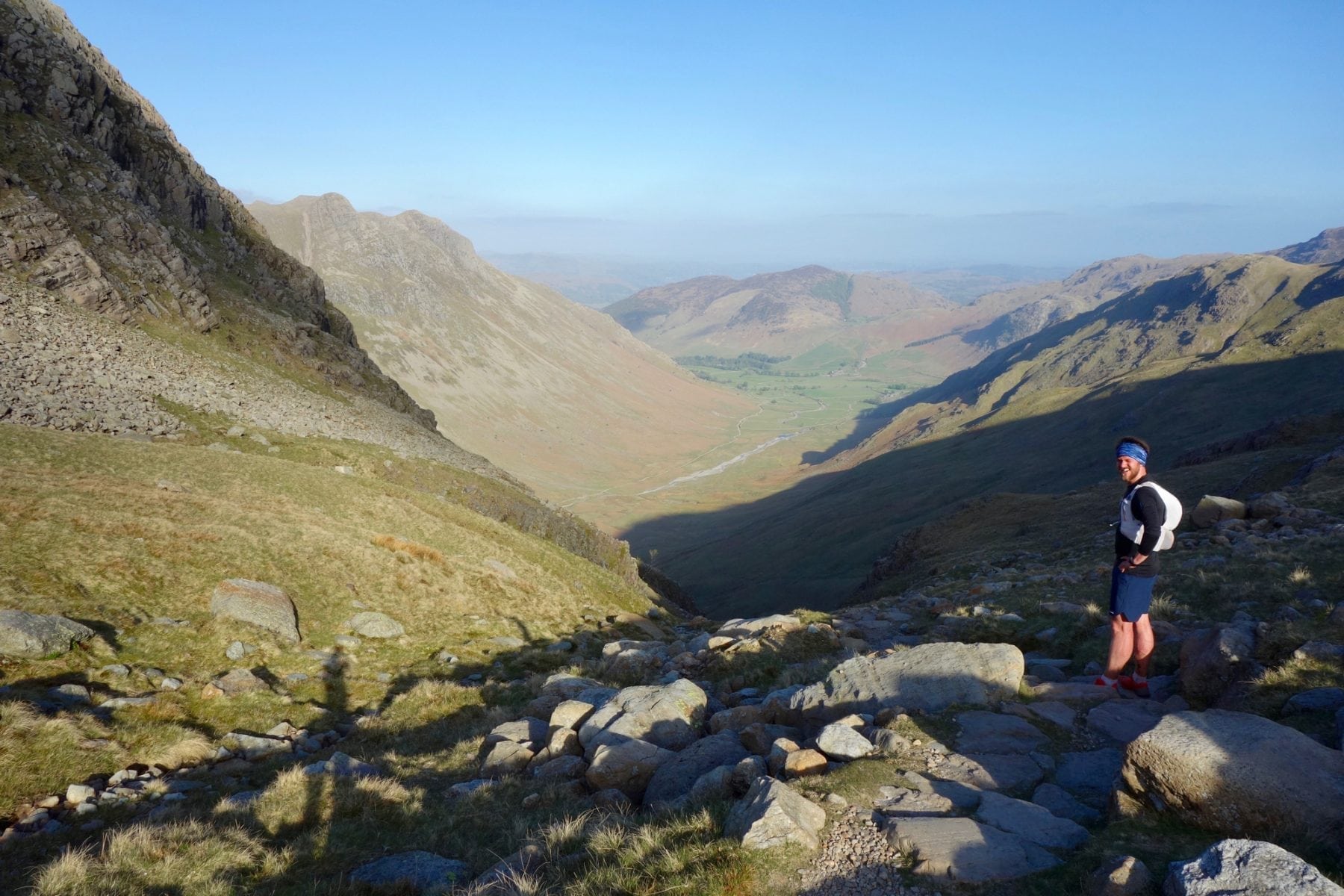
Joe Williams about to descend into Mickleden and, then, on to Langdale after a long day in the fells. Photo: iRunFar/Meghan Hicks
Cumbria Way
I know what you might be thinking at this point, Holy heck, the vertical! Can a person do some flatter off-road running in the Lake District? I’m here to tell you that you sure can. There are thousands of miles of footpaths and some quick math with the topographic lines on your maps will help you find some of the flatter trails.
The Cumbria Way will mostly be up your alley, too. This famous path stretches north-south for 74 miles (119 kilometers) through the Lake District. While this path does, indeed, climb and descend some cols and mountains to get where it needs to go on its north-south journey, it clings to long valley bottoms whenever it can. Buyer beware, flat doesn’t always mean non-technical. Much of the Cumbria Way was and still is the original means of travel for livestock and people in and out of some of these valleys. Thousands of years of good use can often mean rocky as all heck. This isn’t exclusively the case, though, and there are also some beautiful stretches of singletrack.

Valley paths may offer you a bit of rest from all the vertical on the fells. Photo: iRunFar/Bryon Powell
Racing ‘Round the Lakes – Bryon
If I started naming races in or around the Lake District, I’d still be naming names next Tuesday. I’ll pass on that… thank you very much. That’s to say, there are a plethora of off-road races to be found.
Most famously, there are fell races. Fell races are generally off-trail, semi- to fully-self-navigational races that go up, up-and-down, or otherwise connect prominent locations such as a town with its surrounding high points. A fell race could be a 10-minute, all-out solo sprint from town hall to a rocky prominence two-hundred yards above town or a 37-mile circuit connecting high points with a partner at the Old County Tops Fell Race. The breadth and frequency of these races cannot be understated. Check out the Fell Runners Association and Fellrace.org.uk websites for race listings. For a primer on fell racing, take a look at Former General Secretary of the Bob Graham 24 Hour Club as well as former secretary of the Fell Runners Association, Morgan Williams’s, “Fell Running: A Quick Guide – Part 1” and “Part 2” here on iRunFar.
I’ll admit, I’ve dreamt of running a fell race for ages. I’d loved the concept of running up and down a peak, choosing your own line, and going for broke. I’d longed to experience the community and camaraderie that I’d heard surrounded these events. While there are large events, I’d always wanted to run a small, mid-week, from-the-pub, up-and-down fell race, so that’s exactly what I did, and the Caw Fell Race didn’t disappoint.
On race evening, Meghan and I drove the narrow roads to the hamlet of Broughton Mills where we parked in a farmer’s field and headed over to check-in on the patio of the local pub, the Blacksmiths Arms. It’s there that runners kitted out in singlets from Black Combe, Ambleside, Helm Hill, Dallam, or any of the other local athletics clubs prepped before gathering at the informal starting line in the field across from the pub.
At ‘go,’ we sprinted onto the pavement, across a small bridge, and up a short paved climb before hitting the singletrack a few minutes later. The singletrack was optional. Most climbed the already crushingly steep track, while a few crunched more directly up through the waist-high ferns locally referred to as bracken to The Knott, the prominence overlooking the hamlet. Atop that summit, we’re far from done. From there, there’s a general traverse and gradual ascent to the base of Caw proper. Actually, there wasn’t a general anything. Folks ended up taking two wildly different lines over to the base of the peak with nearly everyone taking some personal variant over the open, but highly variable terrain. I huffed up the incredibly steep climb to summit Caw before turning around and descending.
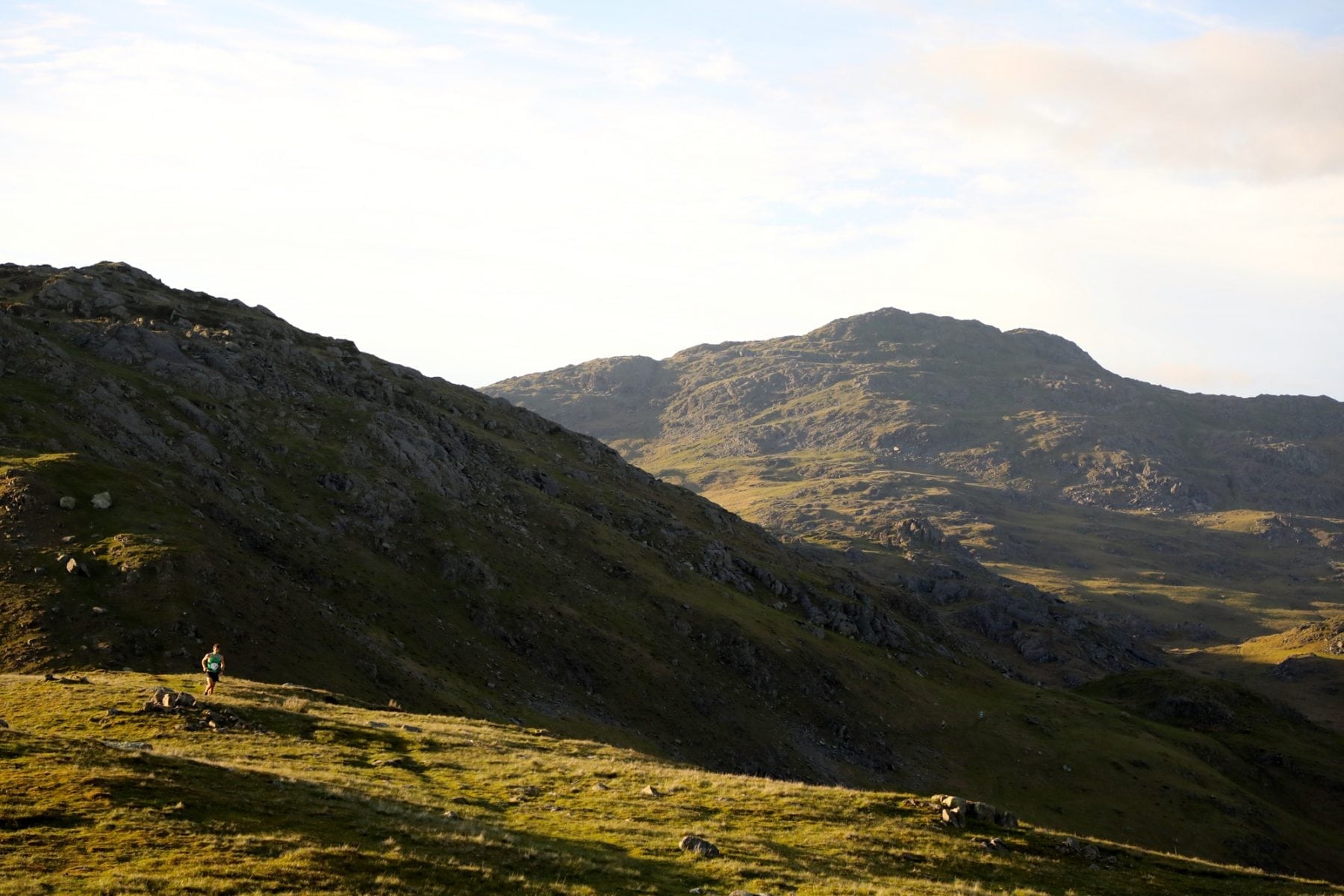
A runner returns from Caw, the taller fell in the background, during the Caw Fell Race. Photo: iRunFar/Meghan Hicks
The descent required complete focus to choose good footing and a good line on the near-vertical grass bits between rocky outcroppings. A quick slip on some loose rock caused my calf to cramp after the stress of the maddening climb. I took a standing 10 count and hoped I would be able to run again. I could, but was also more cautious in the boggy traverse and less reckless on the off-road descent off The Knott. Once I hit the steep pavement, I let my hesitation go and open up to low four-minute pace. It’s fun to fly. There was a little kicker of a quarter-mile grade before I crossed the finish line to a crowd of, perhaps, two-dozen others after my five-mile-and-change journey. We milled about for a bit before heading back to the pub’s patio for the prize giving, where seemingly half the field gets their choice of a beer, wine, or chocolates, whether the prize is merit-based or whatever it is they settled on as the reason to give me a beer. Post-prize giving, half the field stuck around for a pint and, for some, dinner as day faded into night.
There are also trail races in addition to fell races. For instance, I took part in one of the Staveley Trail Races. It was a 10.5-mile mix of a bit of pavement, some doubletrack, a few trails, and faint trods over freshly grazed pastures on moderately, but relentlessly rolling terrain. I’d say it felt refreshingly like a longer, rougher version of the cross-country racing I grew up with. A mere week after running the Thames Path 100 Mile (outside of London), I felt like I was sprinting for the entire race. Toward the end, that sprint was punctuated by a series of stile crossings over gorgeous, centuries-old drystone pasture walls. It was a treat.
Athletics Clubs – Bryon
Seemingly every town in and around the Lake District has its own running club and sometimes two. While some are nominally an ‘athletics’ (track and field in American parlance) clubs, they’ve all got deep histories with and commitments to fell racing. Perhaps, the region is home to something more akin to a running club with a road focus that you’d find elsewhere in the world, but these are fells-first clubs and runners have fierce alliances with them and friendly rivalries with neighboring clubs.
Many of the larger clubs now have a website or a Facebook page that lays out the group run, and often multiple group runs, offered each week. Some clubs publicly invite guests to join up. For the clubs that don’t, I’d suggest reaching out to the club beforehand. Still, I can’t imagine any club not welcoming an (adequately equipped) out of towner to join along for a run in the fells and a pint afterward.
As we were staying in Ambleside, I joined up with Ambleside AC for a Tuesday-night run my first week in town. The run that night started two miles from where we were staying, so I ran over. It also happened to be the start of that weekend’s Fairfield Horseshoe Fell Race that was put on by the very same Ambleside AC. While it wasn’t the plan when we set out, we ended up running the entire route on a jaw-dropping evening. After I took a dip in the frigid local swimming hole, the run ended back at the Badger Bar, where I joined the club for hot tea (I was freezing post-dip), a pint, and some finger food provided by the pub owner, who’d just so happened to run with us that evening. I enjoyed the run enough that I joined Ambleside the following two Tuesdays.
Lee Proctor, a Lake District runner for more than 25 years and, now, the communications coordinator for inov-8, explains the deep importance of clubs in his running, “Nothing makes me prouder than pulling on the green vest of my fell running club, Helm Hill, and toeing the startline alongside my friends and teammates, also in green. It’s brings a feeling of it’s us against them, and when I say them, I mean the likes of Lake District rivals Keswick, Borrowdale, Ambleside. The club rivalry–and perhaps more importantly the banter–is part of what makes fell running so special. The end-of-season fell running club relays are a highlight of the year. Many fell runners would happily hand over prizes won in individual fell race categories to be part of club team that wins the Hodgson Brothers Relay held every October in the heart of the Lake District. Many clubs also play an important role in nurturing young fell running talent. Helm Hill’s Tom Addison is a great example, coming all the way through the club’s junior ranks and fell running coaching system before eventually winning the 2014 English Fell Running Championships as a senior.”
The Pub Life – Bryon
Whether you enjoy a tipple from time to time or are a complete teetotaler, a stop (or a few) at a pub is mandatory during any visit to the Lake District. Quite simply, pubs are the social centers of the towns that dot the region. Morgan Williams explains, “Pubs are historically at the centre of communities here (albeit in decline in recent years), even more so in the rural/countryside locations where fell racing is prevalent. It’s a marriage made in heaven.”
Sure, you’ll find some fancy, tourified ones at the heart of Ambleside or Windermere or Keswick, but even in the most touristy towns, you’ll find something like the real deal—that is a genuine, centuries-old, dimly-lit, fire-heated pub with tables a lot older than you.
If pubs have a large import in general life in the region, it’s all the more so for fell runners. Lee Proctor explains, “Whether it’s a fell race or a training run in the Lake District, lots of fell runners ‘go for a pint’ in the nearest pub afterward. It’s part of the tradition. There’s nothing better than sitting in a pub beer garden with the sweat of the fell race/run still on your face and sharing your experiences with those whom have just done the exact same thing over a pint of local ale. You might be the fiercest of rivals when racing over the fell summits, but you all come together for pint and the prize-giving afterward in the pub. Some pubs take it a step further–for example, the Scafell Hotel has a plaque on its walls of all the Borrowdale Fell Race winners. There’s others, too, with old photos of legendary fell runners hanging in the bar areas.”
The first pub I walked into in the region was the Golden Rule in Ambleside. Sure, there were some tourist hikers hanging out over a pint, but there were also two older gentlemen sitting together over a paper for a couple hours, and a gent who popped in for half a pint, caught up with the regulars for 10 minutes, and headed on his way. Even the most touristy of pubs has real ale, a friendly atmosphere, and, if they serve any, decent food.
Personally, I most enjoyed the most out-of-the-way pubs. May I never forget my time at the Blacksmiths Arms in Broughton Mills, a centuries-old pub that looks like it’s not been updated since it was built. The evening I was there, eight or 10 folks (three staff and a few patrons) carried on in the minuscule bar room. To the other side of the entranceway, a handful of guests enjoyed good hardy dinners in another tiny room with quaint atmosphere and a little fire. Outside, a few-dozen fell runners enjoyed pints and bites following the fell race that started and ended beside the pub. (It should be noted that I never felt out of place in a pub in split shorts and running tee.)
When I asked Morgan Williams his favorite Lake District pub, he couldn’t help but give two answers. “For location, atmosphere, and history, the bar at the Wasdale Head Hotel, nestling under England’s highest mountains, is tops. However, as I’m a long-time Ambleside [AC] member, it must be The Golden Rule at the bottom of Kirkstone Pass for reasons of memories/community/club loyalty.”
As for beverages, always opt for ‘real ale’ if you’re in the mood for a pint of beer. These days, many pubs will have at least a few taps with well-known, keg-fed domestic or international brews. Some are drinkable, but that’s not why you’re here. Instead, a ‘real ale’ will get you a hand-pulled cask-fed pint from one of the hundreds of breweries in England. What’s better is that each pub will have a few different ales with great variety found between the pubs within the same village. If I had two-dozen pints in my time in the Lake District, I never repeated a variety unless it was explicitly by choice. The ales themselves tend to be medium-bodied, mildly hopped, lower-strength brews… just your everyday, totally sessionable ‘ale.’ Few will wow you, but you’re also unlikely to regret your choice either. The one surprise for me was the lack of dark beers on draft (other than Guinness). While these are widely available bottled in stores, they’re rarely on draft. On the hoppier end, any of the larger pubs and some of the smaller ones will have an IPA or an equivalently hoppy beer.
Before moving on, I must plug cider. If you at all enjoy cider, you’ll be a happy man or woman in this part of the world. Nearly every pub will have cider on draft and while you’ll see some brands with regularity, there’s also a large variety to be discovered amongst the pubs. Then, you come across a pub like Troutbeck’s Mortal Man with its cider and perry selection and, well, happy days!
Inov-8 – Bryon
While in the area, I had the pleasure of visiting inov-8’s headquarters a few times. The brand was born in the Lake District and to run in the brand’s products there is an opportunity to see the company’s spirit and to feel its products at their very best. The office itself is a such humble affair that one can hardly believe it’s where a global off-road running brand is headquartered. However, once the crew starts excitedly talking off-road running, laces up their shoes, and pops out the back door right onto the fells… well, that’s when it starts to make sense. The Staveley Trail Races I spoke of earlier started and finished just a few hundred yards from the office and most of the staff took part in one of the races (generally, quite speedily) or, at the very least, was out there demoing product and cheering on runners. Out on our own, Meghan and I respectively tried out the X-Claw and X-Talon on their native terrain in the fells, I in training and the Caw Fell Race and Meghan in the Bob Graham Round… and we loved ’em.
Safety – Meghan
It’s hard to emphasize enough that there are requisite skills for safe trail and fell running in the Lake District. Even if you plan to stick strictly to the trails, you’ll find that there’s rarely a trail sign once you leave the trailhead. With a great many trails, you’ll inevitably encounter a number of intersections in one small run that you’ll need to make your way through. And when the weather turns, it turns. Fog—clag as they call it locally—clouds, and precipitation can and do engulf the entire landscape. Gone will be any form visual navigation cues beyond the terrain immediately in front of you. The weather can change in an instant, too. One two-hour run can include all kinds of weather, from the extremes of warm sunshine to the densest of fog.
If the weather’s shit—and chances are it will be shit at some point if you stay more than a few days—we recommend you stay on the trails which are shown on your map until you gain the competence to have confidence off trail. If you have a good-weather forecast, use those days as a chance to branch out and experiment with off-trail fell running.
Jasmin Paris says that the ability to navigate is the key prerequisite to safely enjoying the Lake District. “The most critical thing is having a map and compass, and actually being able to use them. I remember one time, when Konrad and I were running some of the Wainwrights, and we suddenly heard frantic shouts from a man further along the ridge, who was waving something in his hand wildly. It turned out that his GPS had stopped working, and he had no idea where he was.”
She continues, “On the very same trip, we passed a family in a valley, and they stopped us to ask for directions. When I asked where they were heading to, they weren’t actually able to say. These are obviously the more extreme examples–I think that the majority of people are responsible and well prepared, and can enjoy the Lake District safely as a result.”
Joe Williams agrees with Jasmin that the ability to navigate with navigation gear is the first order of safety business. The second, according to Joe? Good footwear. He elaborates, “Get some proper fell shoes. In any season other than summer, and whenever the ground might be wet, trail shoes, even those with good lugs underneath, just won’t cut it. It’s downright dangerous to be slithering around in some standard trail shoe miles from the nearest road in winter and with minimal safety kit. Get some inov-8s! Oh, and while you’re at it, bring a proper waterproof jacket with a stiffened, cinch-able hood. In shitty weather, these sub-100-gram shells are a total liability!”
Now, here’s the minimum of what I think you need to be safe for a day on the fells:
- Map, compass, and the ability to use them in all kinds of weather. A smartphone with a GPS app and track can be a great option, but you must not place your life exclusively in the hands of fallible electronic devices. Also carry a map and compass.
- Fully waterproof jacket and pants, and some sort of waterproof hand covers.
- Proper footwear with significant lugging and sticky outsole rubber.
- An insulating layer like wool or a wool blend that still performs when sopping wet. Keep it in a plastic bag to keep it dry when you’re not using it.
- A 20-pound note for a stop in the pub afterward.
- Your itinerary left with someone not on the fells with you.
That’s it! I’m only kind of kidding. Really, though, it’s fairly simple to stay safe in the fells, but you must be intentional with your safety.
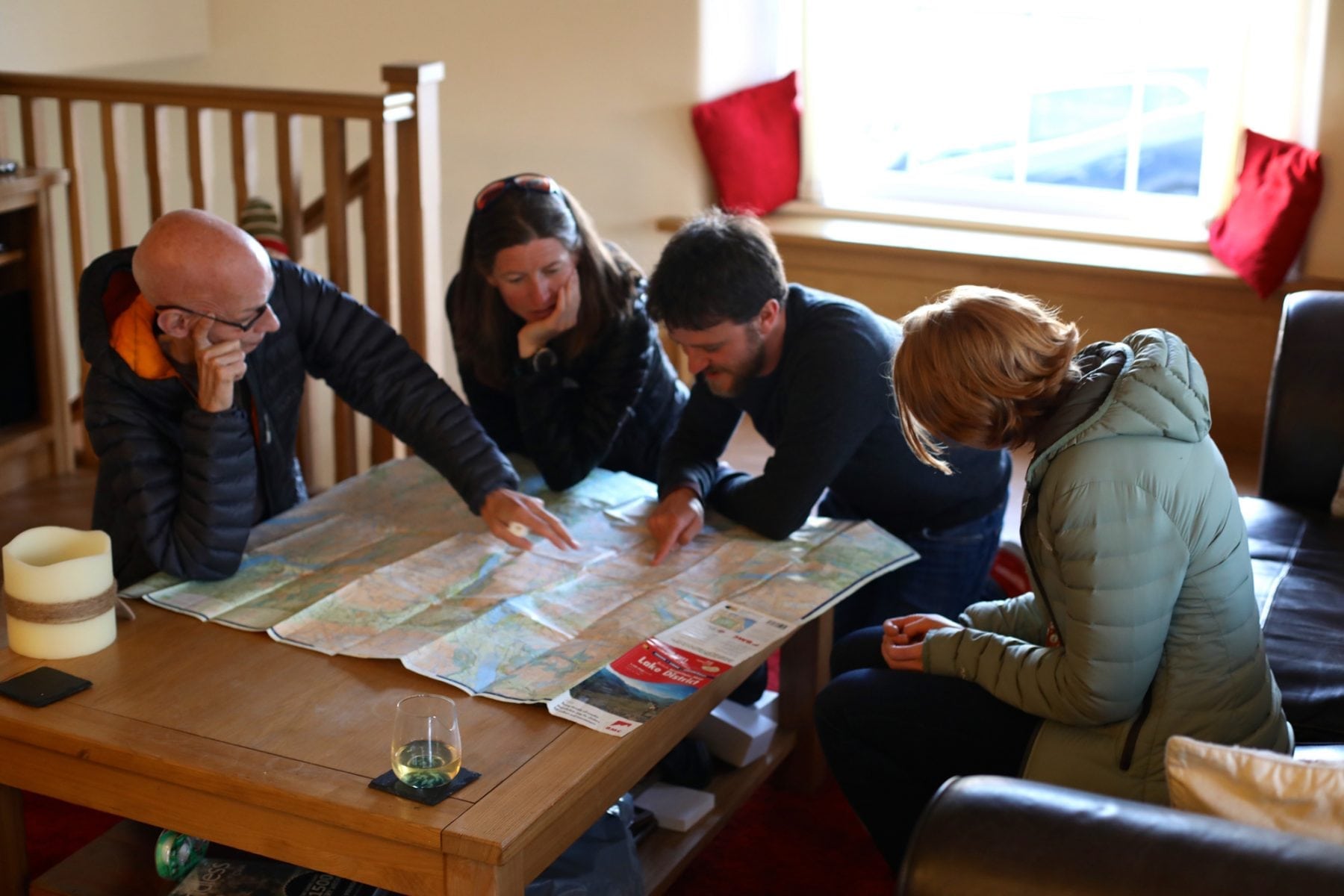
Half the fun of Lake District fell running, studying the maps and planning routes. Photo: iRunFar/Bryon Powell
More Resources – Meghan
Hook, line, and sinker on a trip to the Lake District? If so, I’ve gathered a few resources to help you learn more before you go and once you’re there.
- Cicerone Press is a Lake-District-based book publisher with a number of titles and small pamphlets detailing fell running, trail running, scrambling, mountain biking, and more around the region. Have a look at all their Lake District publications, and take special note of the recently released Trail and Fell Running in the Lake District.
- While there are a number of GPS apps that’ll help with navigation in the Lake District, ViewRanger seems to work quite well and it supplies some extra, location-specific details. Hello, the pubs are on the maps! (See also, Pub Stops of the Lake District for a laugh.)
- Speaking of maps, you’re gonna’ need some, and you should find what you need probably with a combination of the Ordnance Survey and Harvey maps. With Ordnance Survey, you might also like their online tool, OS Maps, software that allows you to map routes in intricate detail before you go out. OS Maps also has an app you can use to navigate on the fells, too.
- The Met Office is England’s meteorological agency, and they publish a Lake District mountain-weather forecast that will become your best friend (and maybe enemy when the forecast is for days of rain).
- If you’d like to learn more about the history of fell running in the Lake District, Feet in the Clouds: A Tale of Fell Running and Obsession by Richard Askwith is a good place to start. Buyer beware, the book goes immediately all in with great detail. Also read Joss: The Life and Times of the Legendary Lake District Fell Runner and Shepherd Joss Naylor by Keith Richardson. The title is descriptive enough, and again you have to be ready for obsessive detail—some stuff that you just won’t understand until your visit is done and dusted—but don’t let this discourage you. Also consider reading the profile of Wynn and Steve Cliff, fell running community members extraordinaire, here on iRunFar.
- I completed the Bob Graham Round during our Lake District visit, and wrote a report on it afterward.
- Oh wait, you want to do and learn more things while in the Lake District besides running? Take a boat ride. A number of the big lakes offer boat rides for taking in the scenery. “I wandered lonely as a cloud…” Poet William Wordsworth lived much of his life in the Lake District and you can visit the Wordsworth Museum and family home, Dove Cottage, in the village of Grasmere. While in Grasmere, you must buy some of the famous and historic Grasmere Gingerbread. There’s something like 12,000 years of known human history in the Lake District, and a number of preserved archaeological sites offer windows into this far past, like the Castlerigg Stone Circle, the Copt Howe Rock Carvings, and the Ravenglass Roman Bathhouse.
Call for Comments
- Live in the Lake District or visit the region regularly? Would you kindly consider leaving a comment with additional information? We’d love to collect more information about the region in the comments section.
- Are you an ‘outsider’ to the Lake District who has participated in a fell race or trail race there? Can you describe what the experience was like and how it was similar to or different from other off-road races you’ve run?
